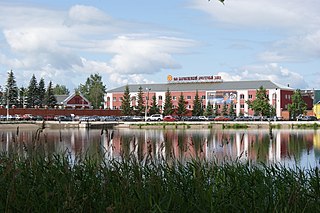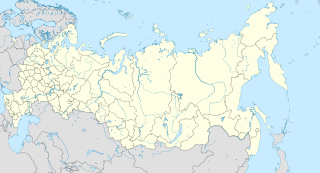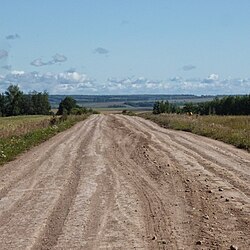
Belebey is a town in the Republic of Bashkortostan, Russia, located on the bank of the Usen River, 180 kilometers (110 mi) from Ufa. Population: 60,188 (2010 Census); 60,928 (2002 Census); 53,443 (1989 Census)..

Blagoveshchensk is a town in the Republic of Bashkortostan, Russia, located 42 kilometers (26 mi) north of Ufa on the right bank of the Belaya River. Population: 34,239 (2010 Census); 32,989 (2002 Census); 27,705 (1989 Census).

Yanaul is a town in the Republic of Bashkortostan, Russia, located on the Yanaulka River, 230 kilometers (140 mi) north of Ufa. Population: 26,924 (2010 Census); 27,909 (2002 Census); 25,727 (1989 Census).

Birsky District is an administrative and municipal district (raion), one of the fifty-four in the Republic of Bashkortostan, Russia. It is located in the north of the republic and borders with Burayevsky District in the north, Mishkinsky District in the northeast and east, Blagoveshchensky District in the southeast, Kushnarenkovsky District in the south, and with Dyurtyulinsky District in the west. The area of the district is 1,786.49 square kilometers (689.77 sq mi). Its administrative center is the town of Birsk. As of the 2010 Census, the total population of the district was 17,924.

Blagoveshchensky District is an administrative and municipal district (raion), one of the fifty-four in the Republic of Bashkortostan, Russia. It is located in the northern central part of the republic and borders with Karaidelsky District in the north, Nurimanovsky District in the east, Ufimsky District in the south, Kushnarenkovsky District in the southwest, Birsky District in the west, and with Mishkinsky District in the northwest. The area of the district is 2,250 square kilometers (870 sq mi). Its administrative center is the town of Blagoveshchensk. As of the 2010 Census, the total population of the district was 15,497.

Burayevsky District is an administrative and municipal district (raion), one of the fifty-four in the Republic of Bashkortostan, Russia. It is located in the north of the republic and borders with Yanaulsky and Tatyshlinsky Districts in the north, Baltachevsky District in the east, Mishkinsky District in the southeast, Birsky District in the south, Dyurtyulinsky District in the south and southwest, and with Kaltasinsky District in the west. The area of the district is 1,820 square kilometers (700 sq mi). Its administrative center is the rural locality of Burayevo. As of the 2010 Census, the total population of the district was 25,154, with the population of Burayevo accounting for 37.9% of that number.

Karaidelsky District is an administrative and municipal district (raion), one of the fifty-four in the Republic of Bashkortostan, Russia. It is located in the north of the republic and borders with Askinsky District in the north, Duvansky District in the east, Nurimanovsky and Blagoveshchensky Districts in the south, Mishkinsky District in the southwest, and with Baltachevsky District in the west. The area of the district is 3,786 square kilometers (1,462 sq mi). Its administrative center is the rural locality of Karaidel. As of the 2010 Census, the total population of the district was 27,945, with the population of Karaidel accounting for 21.4% of that number.

Starosubkhangulovo is a rural locality and the administrative center of Burzyansky District in the Republic of Bashkortostan, Russia, located on the Belaya River. Population: 4,609 (2010 Census); 4,343 (2002 Census); 3,655 (1989 Census).

Buzdyak is a rural locality and the administrative center of Buzdyaksky District in Republic of Bashkortostan, Russia. Its population is 10,323 (2010 Census); 9,733 (2002 Census); 8,719 (1989 Census)..

Fyodorovka is a rural locality and the administrative center of Fyodorovsky District in the Republic of Bashkortostan, Russia. Population: 4,306 (2010 Census); 4,128 (2002 Census); 3,923 (1989 Census).

Iglino is a rural locality and the administrative center of Iglinsky District in Bashkortostan, Russia. Population: 16,811 (2010 Census); 13,931 (2002 Census); 12,879 (1989 Census).

Karaidel is a rural locality and the administrative center of Karaidelsky District in the Republic of Bashkortostan, Russia, located on the Ufa River. Population: 5,980 (2010 Census); 5,174 (2002 Census); 4,284 (1989 Census).

Karmaskaly is a rural locality and the administrative center of Karmaskalinsky District in the Republic of Bashkortostan, Russia. As of the 2010 Census, its population was 8,540.

Akyar is a rural locality and the administrative center of Khaybullinsky District of the Republic of Bashkortostan, Russia, located on the Tanalyk River. Population: 6,941 (2010 Census); 5,549 (2002 Census); 4,278 (1989 Census).

Kushnarenkovo is a rural locality and the administrative center of Kushnarenkovsky District of the Republic of Bashkortostan, Russia, located on the Belaya River. Population: 9,870 (2010 Census); 10,630 (2002 Census); 9,032 (1989 Census). Since 1941 the International Lenin School worked here under a code name of an agricultural college.

Dyurtyuli is a town in the Republic of Bashkortostan, Russia, located on the left bank of the Belaya River 126 kilometers (78 mi) northwest of Ufa. Population: 31,274 (2010 Census); 29,984 (2002 Census); 25,264 (1989 Census).

Priyutovo is an urban locality in Belebeyevsky District of the Republic of Bashkortostan, Russia. As of the 2010 Census, its population was 20,891.

Starobaltachevo is a rural locality and the administrative center of Baltachevsky District of the Republic of Bashkortostan, Russia. Population: 5,598 (2010 Census); 5,601 (2002 Census); 4,171 (1989 Census).

Novobelokatay is a rural locality and the administrative center of Belokataysky District of the Republic of Bashkortostan, Russia. Population: 5,961 (2010 Census); 5,912 (2002 Census); 5,270 (1989 Census).














